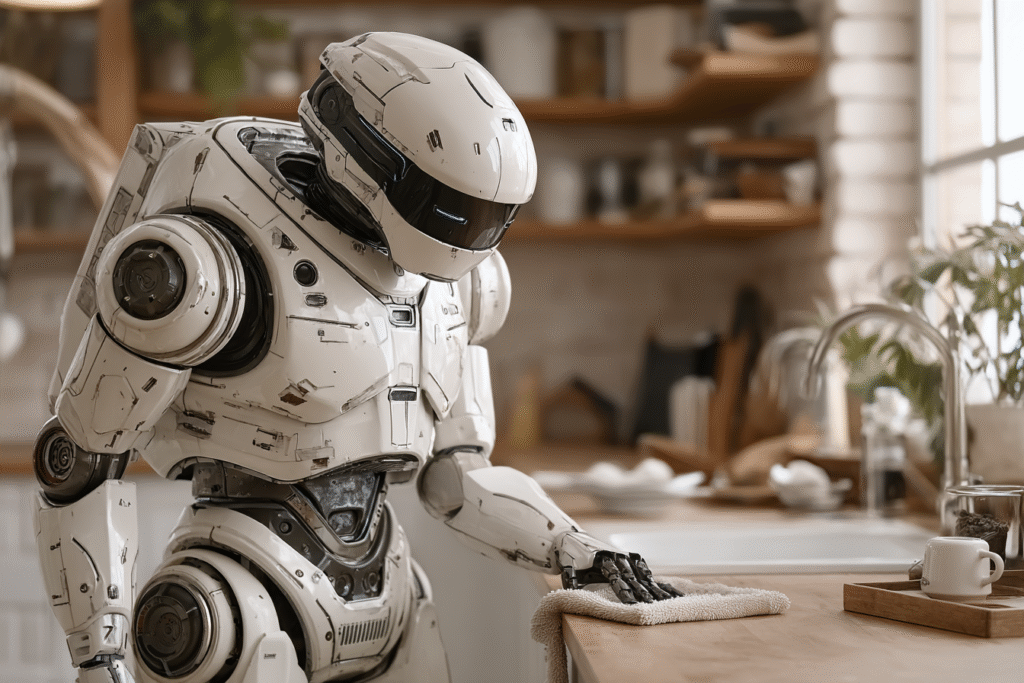
From SRP author Cameron Cooper:
The line between science fiction and reality just blurred again — and this time, I saw it with my own eyes.
This week, Business Insider released a video showing Figure AI’s new humanoid robot, Helix, in action. If you haven’t seen it yet, I highly recommend taking a look. It’s eerie, astonishing, and oddly captivating. Picture this: a sleek humanoid in a metallic exoskeleton, flipping boxes with casual precision, moving with a human rhythm, and performing work that until now belonged to warehouse workers, not machines.
I couldn’t stop watching it. Helix looks like a blue-collar Iron Man, minus the bravado and quips, but with an utterly real ability to work. When it flipped a box in the demo, it felt disturbingly human.
And that’s exactly the point.
Who is Figure AI?
If you haven’t heard of Figure AI, you’re not alone. They’ve only existed since 2022. But in that short time, this Silicon Valley startup has attracted serious attention (and funding). Their founder, Brett Adcock, previously launched Vettery and Archer Aviation (the flying taxi company), but with Figure AI, he’s aiming even higher: humanoid robots at human scale and human skill.
They’ve raised over $2.3 billion as of early 2025, with backing from Microsoft, Nvidia, OpenAI, and Jeff Bezos — yes, that Bezos — and their flagship robot line is already working in BMW factories.
The Helix robot itself is designed around a breakthrough called a Vision-Language-Action (VLA) model (Figure AI news release). It sees the world, understands instructions in plain English, and then acts; fluidly, flexibly, intuitively. In the video, Helix navigates clutter, adapts mid-task, and does it all at a pace that feels natural…almost too natural.
How Soon Before These Robots Are Everywhere?
Brett Adcock is very bullish on the timeline. He predicts that robots capable of doing useful household work — not just factory tasks — will show up in homes within “single-digit years.” Translation: by 2030–2034, your next housemate could be Helix or something like it.
But that’s just the start. Adcock has gone further, suggesting that one day there will be “as many humanoid robots as humans” on Earth.
Other voices are chiming in too. Futurist Adam Dorr argues that by 2045, most human jobs could be automated away, with robots and AI doing everything from logistics to retail to food service.
Even Nvidia’s Jensen Huang, one of the architects of the modern AI revolution, has publicly predicted humanoid robots will become “omnipresent and commonplace” by 2039.
In other words: what we’re seeing today is just the prototype stage. The industrial models like Helix are proving themselves on warehouse floors now. The home versions will come soon — cleaning, cooking, carrying — and they’ll probably get cheaper, faster, and more capable faster than we expect.
Freaky or Fantastic?
Watching Helix work felt uncanny because it wasn’t just the dexterity or speed — it was the human-like pauses, corrections, and adaptations. The effect is subtle but powerful: this isn’t a dumb automaton repeating one preprogrammed movement. This is a machine observing its environment, thinking (in a very machine-learning way), and then executing a task with near-human competence.
And that raises all the questions that science fiction has been asking us for decades:
- How comfortable are we with machines in our intimate spaces?
- When do robots stop being tools and start becoming something more?
- What happens to human labor when robots are faster, cheaper, and tireless?
For my part? If Helix will make me dinner and clean the house, I have no objections whatsoever. I’d celebrate. But there’s no denying that seeing one in my kitchen would be a brain-bending moment.
The Future in Our Homes
Figure AI’s next goal is mass production. They’ve already built a fully robotic manufacturing facility — BotQ — that can assemble these humanoids by the thousands per year. Their target is 100,000 robots annually by 2029.
It’s one thing to read that on paper. It’s another thing entirely to watch Helix calmly flipping a box and realize that this future isn’t decades away. It’s happening now.
So if you thought science fiction was safely confined to books and screens… well, maybe check your kitchen again in a few years.
If you want to see Helix in action, here’s the Business Insider article and video. But be warned — it might blow your mind too.
Over to you: How would you feel about a robot like Helix in your kitchen? Would you welcome a robotic housemate if it meant less cooking and cleaning? Or is this future moving too fast for comfort?
Tell me what you think in the comments — I’m genuinely curious where this sits on your comfort scale!

Cameron Cooper
SRP Author
Check Cam’s books here on Stories Rule Press.



